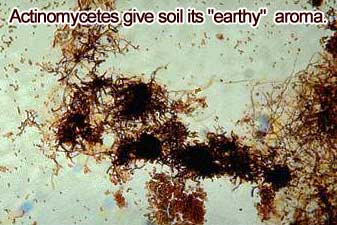So what is the Soil Food Web any way? Many people are unaware that the soil in our fields and gardens contains a vast community of microscopic and larger organisms which feed upon organic matter and each other thereby transforming our soils into a living web of interrelated organisms. Without these beneficial creatures, all higher life forms would cease to exist.

 Beginning at the lowest levels, bacteria and fungi feed upon plant and animal organic matter including the metabolites (waste products) from plants, animals and microbes. These organisms then become dinner for protozoa, nematodes and arthropods (insects), which in turn are preyed upon by larger arthropods and nematodes, which become a food source for birds and animals (See The Soil Food Web Graphic). Every step of the Soil Food Web is both a transfer of energy to the higher creatures as well as a cyclical process which converts minerals and nutrients into forms that plants utilize for their growth and disease resistance. Disrupting this food web eventually disrupts the ability of plants to function properly.
Beginning at the lowest levels, bacteria and fungi feed upon plant and animal organic matter including the metabolites (waste products) from plants, animals and microbes. These organisms then become dinner for protozoa, nematodes and arthropods (insects), which in turn are preyed upon by larger arthropods and nematodes, which become a food source for birds and animals (See The Soil Food Web Graphic). Every step of the Soil Food Web is both a transfer of energy to the higher creatures as well as a cyclical process which converts minerals and nutrients into forms that plants utilize for their growth and disease resistance. Disrupting this food web eventually disrupts the ability of plants to function properly.

Undisturbed and infrequently disturbed soils with adequate organic inputs (such as leaves and branches etc. in forest soils) reach an equilibrium state where the Soil Food Web continuously provides the nutrients needed for the higher plants and animals. If the organic inputs for these soils are restricted by climactic changes or human activities, the trees and plants growing on them will suffer.
Healthy soil, with the right amount of organic inputs, is sustainable soil. Soils that are low in organic matter (4% to 10% is  recommended) are not going to provide adequate food for Soil Food Web organisms. These organisms in turn will not be able to provide all of the essential nutrients needed for healthy plant growth and production. It is not uncommon for the quantity and type of food web organisms living in human altered soils (lawns, gardens, athletic fields, agricultural land etc.) to be severely depleted by the continuous use of toxic pesticides and fumigants.
recommended) are not going to provide adequate food for Soil Food Web organisms. These organisms in turn will not be able to provide all of the essential nutrients needed for healthy plant growth and production. It is not uncommon for the quantity and type of food web organisms living in human altered soils (lawns, gardens, athletic fields, agricultural land etc.) to be severely depleted by the continuous use of toxic pesticides and fumigants.
Compost and other organic materials (green manures, animal manures etc.) are amended to soils to build organic matter, improve soil structure and provide the basic needs of a healthy Soil Food Web. Compost has a special impact upon severely degraded soils by not only providing the organic matter needed for the Soil Food Web but also an army of beneficial microbes which will help to rebuild the ravaged soil community.

Whether your soil is obviously depleted of organic matter and food web organisms (you never see earthworms, your plants are not doing well), you just don’t know, or you want to know more about your soil’s chemistry and health, it’s very important to send soil samples to a professional soil testing laboratory. With the information provided by a professional Soil Analysis Report, and possibly the assistance of a land care professional (See References), you will be able to provide the organic inputs needed to dramatically expand the population and diversity of your Soil Food Web organisms. Healthy soils, and productive plants make happy people.
 Further Soil Food Web information can be learned from www.soilfoodweb.com as well as by reading the Soil Biology Primer published by the Soil and Water Conservation Society.
Further Soil Food Web information can be learned from www.soilfoodweb.com as well as by reading the Soil Biology Primer published by the Soil and Water Conservation Society.

related link: NRCS thanks to NRCS site for microscopic photos


